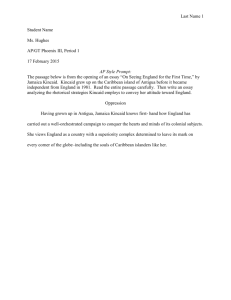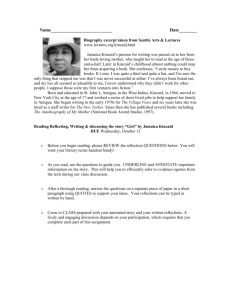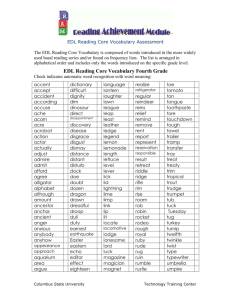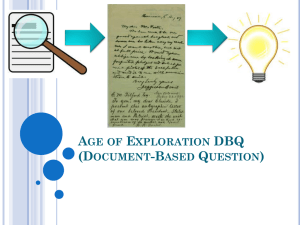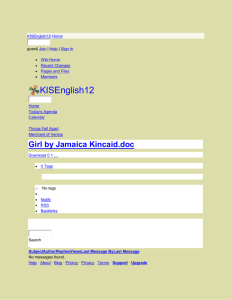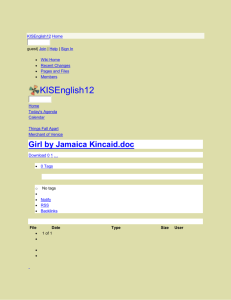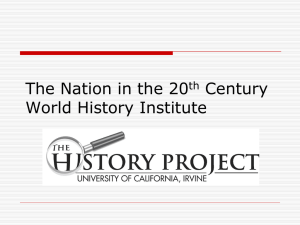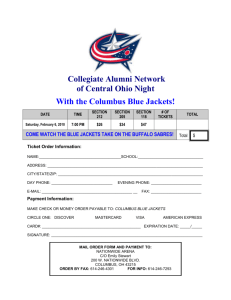Comparing and Contrasting “Columbus` Letter Describing His First
advertisement
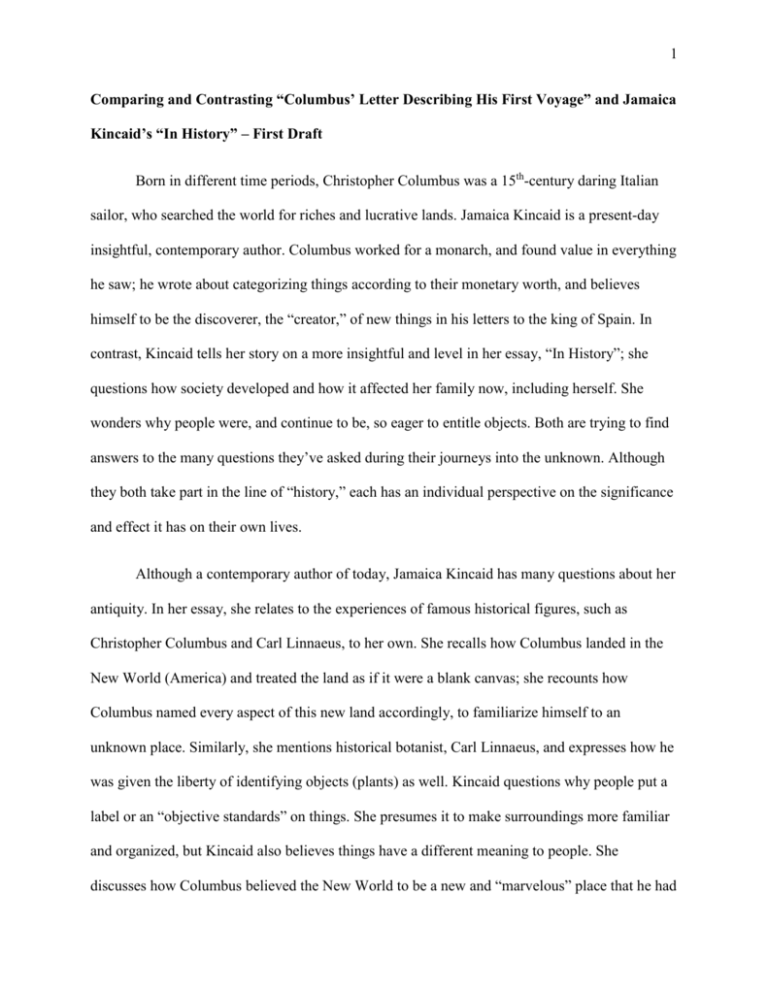
1 Comparing and Contrasting “Columbus’ Letter Describing His First Voyage” and Jamaica Kincaid’s “In History” – First Draft Born in different time periods, Christopher Columbus was a 15th-century daring Italian sailor, who searched the world for riches and lucrative lands. Jamaica Kincaid is a present-day insightful, contemporary author. Columbus worked for a monarch, and found value in everything he saw; he wrote about categorizing things according to their monetary worth, and believes himself to be the discoverer, the “creator,” of new things in his letters to the king of Spain. In contrast, Kincaid tells her story on a more insightful and level in her essay, “In History”; she questions how society developed and how it affected her family now, including herself. She wonders why people were, and continue to be, so eager to entitle objects. Both are trying to find answers to the many questions they’ve asked during their journeys into the unknown. Although they both take part in the line of “history,” each has an individual perspective on the significance and effect it has on their own lives. Although a contemporary author of today, Jamaica Kincaid has many questions about her antiquity. In her essay, she relates to the experiences of famous historical figures, such as Christopher Columbus and Carl Linnaeus, to her own. She recalls how Columbus landed in the New World (America) and treated the land as if it were a blank canvas; she recounts how Columbus named every aspect of this new land accordingly, to familiarize himself to an unknown place. Similarly, she mentions historical botanist, Carl Linnaeus, and expresses how he was given the liberty of identifying objects (plants) as well. Kincaid questions why people put a label or an “objective standards” on things. She presumes it to make surroundings more familiar and organized, but Kincaid also believes things have a different meaning to people. She discusses how Columbus believed the New World to be a new and “marvelous” place that he had 2 discovered, but another person, like a native, could have another outlook. She expresses that discovering something was personal in the eye of the “finder,” how one thing could be so precious and extraordinary to one person, but yet, in another’s eye, it could possibly be old and worn out. It varied on what the person was searching for; she compares her outlook and an artist’s looking at her homeland, Antigua. All Kincaid sees are banal fields of green, while an artist sees seas of green with flecks of different colors. Likewise, Columbus saw Antigua as another island to establish Christianity, while it was Kincaid’s homeland, her birth place. This signifies how Kincaid really questions how the events of the past have affected her family generations, and how it affects her now; because of Columbus’ establishing his religion, Kincaid notes that her family has always been religious since. Kincaid raises many insightful and rhetorical questions about the idea of “history,” like writing, “What to call the things that happened to me and all who look like me? Should I call it history? If, so what should history mean to someone like me? (Kincaid 1)” She compels readers to draw their own conclusions and interpretations about the messages she conveys. In contrast, Columbus had a more evaluating and standard view of history. In his letter to the king and queen, he lands on an island, which he has named San Salvador, in addition to the many other islands he had named. His main voyage to the “Indies” was to look for riches, in particular, valuable spices. He was hopeful to find large cities full of people to also guide him in the right direction. He describes the land as “a marvel,” blooming with unfamiliar flora and fauna. Columbus also depicts as the native there to be primitive, wearing nothing but leaves or cotton. He also characterizes them as almost childish, becoming enthusiastic about the small gifts they have given them. Columbus seems to describe everything according to how much purpose and worth it has; he recounts how even the worthless things to the sailors seemed to be the most 3 valuable item in the world to the natives. Nonetheless, another of Columbus’ main goals was to establish his religion, Christianity, among the natives. He enslaved those who would not convert peacefully and was able to elicit information about the lands; everything Columbus accomplished had a purpose, a goal, behind it. He looked at things on a business level, since he was exploring under the king and queen of Spain; he needed to please them. He was on the pursuit for what the monarchs wanted, not to intellectually discuss deeper matters. He wanted religious and monetary gain as noted in his letter, “And afterwards for temporal benefits, for not only Spain but all Christians will have hence refreshment and gain (Columbus 18).” His letter was solely based on his own experiences and desires; it did not provide the perspectives of other people, like the natives, unlike Kincaid’s essay, where she explored multiple people’s points of views. Although both had very different questions and goals from their experiences, they both described them from their own standpoints, in first person. They both questioned the situations they were in, their surroundings and the people involved; Columbus scrutinizes the natives and Kincaid mentions (not only Columbus and Linnaeus) her family. Each seems to consider how their actions have affected them, such as how Kincaid wonders if past events affected her family and her life now. Columbus also notes the negligible trinkets as treasure in the eyes of the natives while Kincaid contrasts her view and an artist’s/Columbus’ view about her homeland. Together, they both incorporated the idea of things having different value to an individual. Some people might wonder what these two authors, an Italian nautical navigator and a modern day author, could have in common. Both are searching for an ultimate answer, whether it is a source of gold and valuable spices or just a justification on how history conclusively affected her life today, or what history even is. They both reminisce and live in the moment of their 4 discoveries, revelations and experiences, but each independently interprets and concludes how important it is to them.
